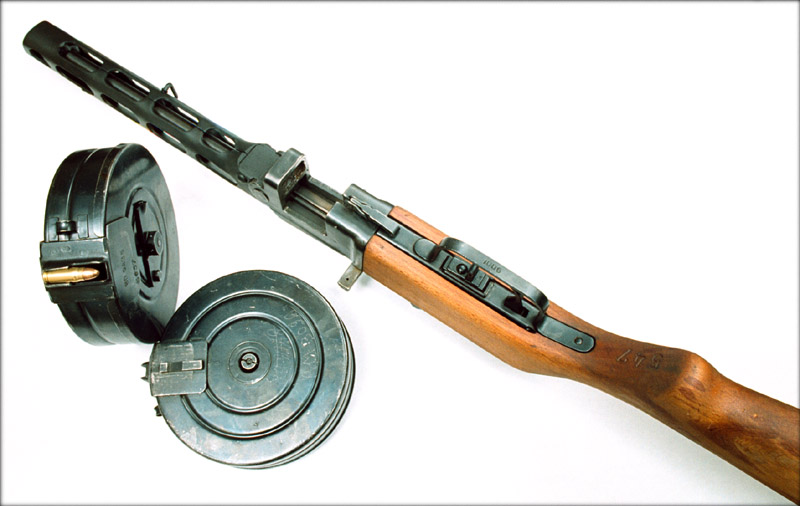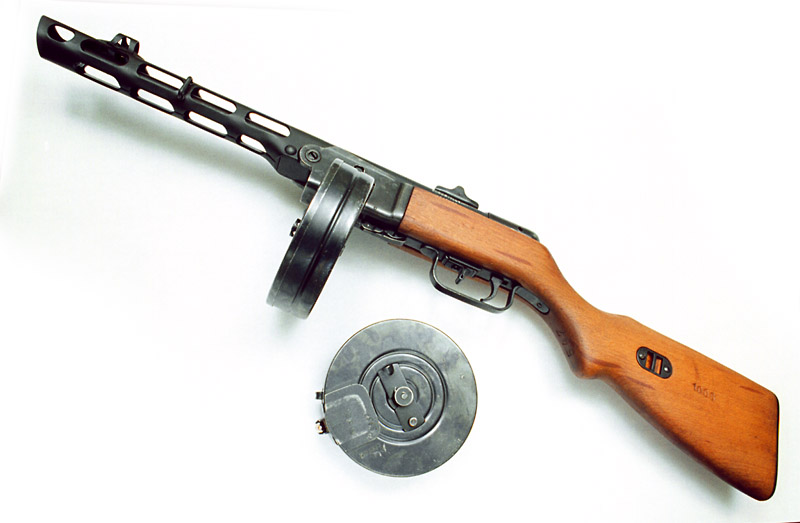|
|
|
|
|
|
|
|
|
|
|
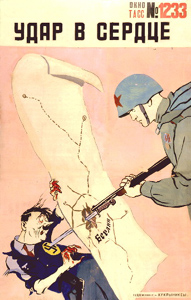
This propaganda poster
says: "Stab into the Heart".
In the late 1930s Stalin's Government desided that it was time to rearm
the Soviet Army with a rifle, that was more up to date than Mosin rifle
1891/1930. As it was considered waistful to use fully automatic weapons,
the preference was given to a semiautomatic design. Several designs were
looked at and adopted. The best and most numerous one was SVT-38. SVT stands
for "Samozaryadnaya Vintovka Tokareva" - "Selfloading Rifle of Tokarev".
Just like with planes, the Russians honored the designer of a gun by including
his name into the official name of the model. After the Winter War the
SVT-38 was modified into SVT-40
Production of the SVT-40 on a mass scale began on July 1, 1940, with
the simultaneous curtailment of the Mosin Nagant Model 1891/30. It was
the Soviets intention to arm all infantry units with the new self-loading
rifle. This explains why early war dated Mosins are difficult to find.
Production was slow at first but still ahead of its forebearer, the SVT-38.
This was due in part to streamlining the production method and simplified
parts as well as the worker's experience. The new SVT-40 was 122cm ( 48.0
inches ) in overall length and 3.9kg (8.5 lbs.) unloaded. As SVT-38, the
new rifle used 10 rounds box magazine. It now had a 62.5cm ( 24.60 inches
) long barrel that retained the same four groove right hand riffling. Its
sights were set to 1500 meters and the muzzle velocity of the type D ball
ammunition was now 765mps ( 2524fps ). SVT-40 production in its first month
was reported at 3,416. In August 8,100 rifles were completed and another
10,700 and 11,960 in September and October respectively. No production
figures are shown for November and December but an educated guess would
be 14,000 for November and 18,000 for December, This would bringing
the 1940 production to around 66,000 rifles. Ishevsk started production
slightly later than Tula, perhaps in the fall, as they had to cease production
of the SVT-38 and retool for the model 1940. Both arsenals produced the
rifle right up to the beginning of 1942, when the order was given for Ishevsk
to begin production on the Mosin Nagant on a full scale basis again. Tula
produced the rifle until the order was given to cease production on January
3, 1945.
Before the Soviet Union was attacked, large numbers of the SVT-40 rifles
was produced. The first weapon issued to my grandfather, just a draftee
reservist, was this rifle. This could be the evidence of the quantities
of the SVT-40s available even in the besieged city of Odessa. The regular
troops and for sure the elite troops, like marines, were definitely armed
with this rifle. Germans captured large numbers of this weapon and used
it themselves. SVT-40 could be also fitted with a sniper scope and used
as a sniper rifle, although Mosin 1891/1930 rifle was prefered in this
role. For details go to this
site.
Here are some pictures:
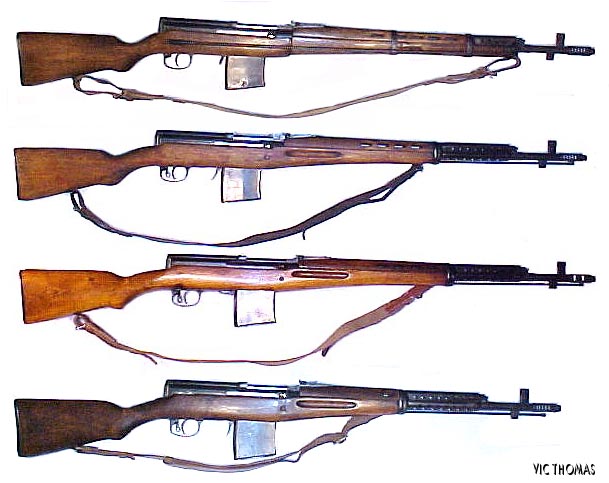
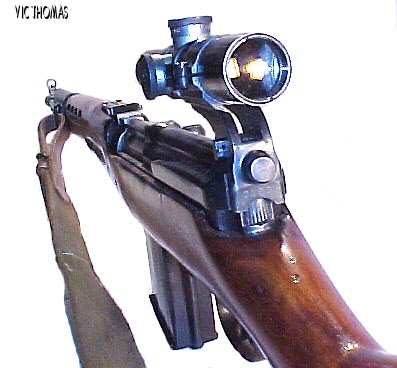
SVT-40 sniper rifle. |
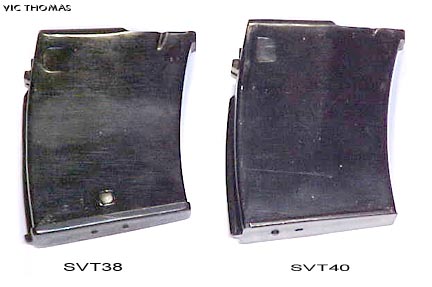
SVT magazines. |
Technical data:
Length: 1.222 m (48.1 in.);
Length of barrel: 625 mm (24.6 in.);
Weight: 3.89 kg (8.58 lb.);
Caliber: 7.62 mm (0.3 in.);
Muzzle velocity: 830 m (2723 ft)/sec;
Magazine: 10-round box.
The Nagant revolver was the designed in Liege, Belgium in 1892 by Leon Nagant. Leon was the brother of Emile Nagant, who designed the box magazine on the famous Mosin Nagant M1891 rifle. Leonís design was adopted by the Russian Army as its official sidearm in 1895, and became known by the designation M1895 or M95. Early production of pistols, both commercial and military, were made in Liege, Belgium. Russian production began at Tula in 1900 (MK). In early years there was 2 versions: soldier's Nagant - single action, and officer's Nagant - double action.
The most unique feature of this design was the gas seal. When the gun was cocked, the cylinder was moved forward and the gap between the chamber and the barrel closed.
The Nagant was used by the Russian, Greek, and Polish armed forces,
as well as many police agencies throughout Europe. The M1895 served the
Russian armed forces until it was replaced by the Tokarev Model 33 7.62
semi-automatic pistol sometime in the 1930ís. Even after the T33 became
available, many Russian armored troops continued to use the Nagant, because
the T33 barrel would not fit out of the
firing slits in the armored vehicles. Production was discontinued in
1945. The details can be found here.
Technical data:
Length: 9 in.;
Length of barrel: 4.25 in.;
Weight: 29 ounces;
Caliber: 7.62 mm;
Muzzle velocity: 1080 ft/sec;
Ammo load: 7 rounds.
| Nagant revolver Model 1895. |
Nagant cocked.
There is not much to add. The MP40 from the original WW2GI can obviously be used. But magazine capacity should be corrected, if possible, to 32 rounds.
Technical data:
Calibre: 9 mm;
Length (stock extended): 833 mm (32.80 in.);
Length (stock folded): 630 mm (24.80 in.);
Length of barrel: 251 mm (9.88 in.);
Weight loaded: 4.7 kg (10.36 lb.);
Magazine: 32-round box;
Rate of fire, cyclic: 500 rpm;
Muzzle velocity: 365 m (1200 ft.) per second.
The 7.62 mm Ruchnoy Pulemyot DP (Degtyaryov-pekhotny) was adopted by the Soviet army in 1928. "Ruchnoy Pulemyot" means "Hand-held Machine Gun", and "pekhotny" means "infantry". Degtyaryov is the name of the designer. It was extremely simple, yet remarkably reliable and robust. It remained the standard light machine gun throughout WW2 and until the 50's, and large numbers of them were used by the North Korean and Chinese Communists in the Korean war. The secret of the DP was the simple locking device, which makes use of locking flaps on the belt, pushed out by the firing pin. The DP proved resistant to dust and dirt, and free from any serious vices. It used standard rifle round, the same one that was used in the Mosin 1891/1930 rifle. This site is where this information comes from.
Technical data:
Operation: Automatic fire, only;
Length: 50.8 in. (1290 mm);
Weight unloaded: 20 lb 8 oz (9.12 kg);
Barrel: 23.8 in. 4 grooves, right hand twist;
Magazine: 47 round detachable pan;
Cyclic Rate: 500-600 rpm;
Muzzle velocity: 2760 fps, 2900 ft-lb;
Ammunition: 148 gr bullet, 48 gr charge, Russian Light Ball M'08;
Effective Range: Probably about 1000 meters.
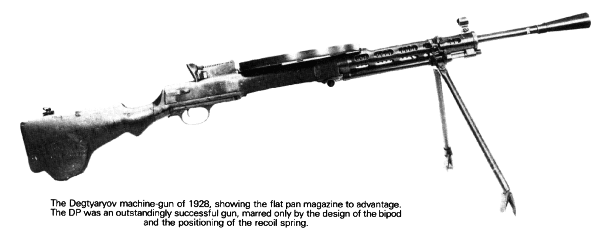
During World War Two two Soviet antitank rifles were used: a single-shot PTRD-41 (Degtyarev's antitank rifle) and a five-shot PTRS-41 (Simonov's antitank rifle). PTRD-41 was more common and prefered, as it was more reliable.
During 1930s in the USSR several projects on antitank rifles were undertaken. However, due to wrong assumption that Germany might have tanks with very thick armor (over 45 mm) most of those projects were canceled. As a result, at the beginning of the Great Patriotic War (June 22, 1941) Soviet infantry was unprotected against the German AFVs. In July 1941, to improve the situation, the GKO (Committee of Defense) ordered both Degtyarev and Simonov to develop an effective anti-tank weapons for the infantry needs. The result was two anti-tank rifles.
When the Germans introduced heavy tanks to the operations, the anti-tank rifles still continued to be used against lighter vehicles. Some light armoured cars, including Lend-Lease Universal Carriers, mounted these rifles as their main weapon. Germans also used captured antitank rifles. Some details about armour penetrating capabilities and some pictures can be found here. These guys have some unreasonably strict rules about using their stuff, so I am not puting any of their stuff on this site. When I have time, I'll scan the pictures from my "Encyclopedia of Weapons of World War 2" and put them here.
Technical data:
Caliber: 14.5 mm (0.57");
Weight: 17.3 kg (38.14 lbs);
Length: 2.02 m (6'7.5");
Length of barrel: 1.35 m (4'5.1");
Muzzle velocity: 1010 m/s;
Effective range: 1000 m;
Rate of fire: 8 - 10 shots/min;
Armour penetration: 25 mm (0.98") at 500 m (547 yards).
All it was a bottle filled with some flamable liquid. Details are here.
When you think of an American GI during WW2, you always imagine him with an M1 Garand rifle. You always imagine a German WW2 soldier with an MP40 submachine gun, even though there were much more of them armed with a Mauser rifle. The weapon that undoubtedly symbolizes a Soviet soldier during WW2 is a PPSh-41 submachine gun. The Russians called it PPSh (peh-peh-shah). It is a Russian abbreviation for "Pistolet-Pulemyot Shpagina" - "Submachine Gun of Shpagin". Georgy Shpagin was a designer of this great weapon. The PPSh had some excellent predecessors: Fyodorov's "avtomat" - automatic rifle - of 1915, that saw some very limited use in the Russian Imperial Army during WW1; Finnish "Suomi" submachine gun, that the Rusians experienced during the Winter War; and, finally, Degtyarev's PPD-40 submachine gun. But PPSh was clearly the peak of submachine gun developement at that time. It was unique in its simplicity, ruggedness and reliability, that Russian small arms are to this day still famous for. But some of the most important features were that there was no screws at all required for its assembly, and all the parts were made by cold stamping. So every tin can factory could manufacture these guns in large quantities, and Russians made over 5 millions of them during the war. The Soviet army was probably the only army during WW2 that was armed almost exclusively with automatic weapons - PPSh-41. The only maintanance these guns needed was to keep them dry - free of any lubrication. Remarkably, despite its simplicity, it had higher rate of fire and accuracy than any other submachine gun used by anybody in WW2. This weapon was also the weapon of choice for the German soldiers. They captured a lot of them in course of the war and loved their reliability, accuracy and 71 rounds drum magazines. The Germans even rechambered it for their standard 9 mm round and used their standard 32 rounds box magazines with it. But the front line soldiers really prefered the original PPSh with the original drum. The details about this great weapon can be found here. Also, take a look at the Russian poster on this site. If you click on different areas of this poster, it will show you the English translation.
Technical data:
Cartridge: 7.62x25 (interchangeable with 7.63 Mauser; aka- .30 Mauser)
Type of Operation: Blowback
Cyclic rate: 900 rpm
Muzzle velocity: c.1600fps (488mps)
Type of Fire: Selective: full-automatic and semi-automatic
Length: 33.10 in. (828mm)
Barrel: 4 grooves, right-hand twist
Barrel Length: 10.60 in (265mm)
Weight unloaded: 8 lbs. (3.64 kg), with drum 12 lbs. (5.40 kg)
Type of Feed Mechanism: Single position feed, stamped sheet-metal,
curved box magazine. Also, a
drum magazine similar to the PPD type, but possessing two feed lips.
Magazine capacity: 35 round detachable box or 71 round drum
Note: 71 round drum was more common and should be used in this game
Weight of Loaded Magazines: 1.5 lbs, box type (.680 kg), 4 lbs. drum
type (1.840 kg)
Sights: Tangent with open "U" notch, adjustable from 50 to 500 meters.
On the later models, there is an
open "U" notch "L" flip rear sight set for 100 and 200 meters.

